Employing Decorative Composition Between Originality and Contemporary in Furniture Designs
DOI:
https://doi.org/10.51173/jt.v3i4.410Keywords:
Decorative Composition, Originality and ContemporaryAbstract
The decorative composition represents one of the most important aspects of heritage as the cultural value that affects one way or another on the successive generations. Many furniture designs that bear contemporary formal values have emerged, at a time when the issue of contemporary and its relationship to originality is one of the important issues that occupy the Arab community. The idea of the designer, and hence the research problem arose with the following question: How is the decorative composition employed between originality and contemporary in furniture designs? while the goal of the research is embodied in revealing the mechanism of employing decorative composition between originality and contemporary in furniture designs. As for the limits of the research, it was objectively determined by studying the employment of decorative formations between authenticity and contemporary, while ensuring its spatial and temporal limits in what Pinterest offers for the year 2021. The theoretical framework of the research consists of two sections, the first dealt with the concept of decorative composition, and the second dealt with the concepts of originality and contemporary. For fidelity and stability. The analysis process resulted in a number of results, the most important of which are: The designs of the decorative composition emerged bearing essential qualities and also expressive of an art that indicates originality and contemporary at the same time within a design fabric that carries a specific intellectual direction, which is to show the aesthetics of the originality of furniture designs, but in a contemporary way. This was embodied through the employment of elements Formalism of decorative composition Line, shape, color, texture, size, area and measure, direction. Relying on the foundations of decorative composition balance, proportion and proportion, unity and diversity, repetition, compatibility, harmony, supremacy, which created designs characterized by balance and wonderful organization of design elements and their relationships with each other to achieve an aesthetic value for those designs.
Downloads
References
Mohsen Mohamed Attia, Discovering Beauty in Art and Nature, World of Books, Cairo, Egypt, 2005, p. 57.
Iyad Hussein Abdullah Al Husseini, The Artistic Composition of Arabic Calligraphy According to Design Foundations, House of Cultural Affairs, Baghdad, Iraq, 2002, p. 120.
Ismail Shawky, Art and Design, Al-Omraniya Offset Press, Cairo, 1999. Pg. 131.
Ahmed Abdel Glob Al-Hasani, The Role of Contemporary Technology in Rooting Ornamentation in Arab-Islamic Architecture, Department of Architecture, University of Technology, Master’s Thesis, Baghdad, Iraq, 2018. P40.
Salim Luay Muhammad Ali, Decoration between Form and Meaning, Department of Architecture, College of Engineering, University of Baghdad, Master's Thesis, Baghdad, Iraq, 2003. p. 25.
Abdel Fattah Riad, Formation in Fine Arts, 1st Edition, Dar Al-Nahda Al-Arabiya for Publishing, Cairo, Egypt, 1974. pp. 77-242.
Jerome Stolnitz, Art Criticism, Aesthetic and Philosophical Study, see: Fouad Zakaria, Ain Shams University Press, Cairo, 1974. p.4.
Qasim Hussein Saleh, Creativity in Art, National House for Publishing and Distribution, Baghdad, Iraq, 1982. p. 21.
Kie Tomita "Principles and Elements of Visual Design: A Review of the Literature on Visual Design of Instructional Materials" Educational Studies-International Christian University. April 2015.
Azhar Karim Al-Sharifi, The Structure of Design in Dia Al-Azzawi's Drawings, Unpublished Master's Thesis, University of Babylon, College of Fine Arts, 2009. p. 36
Furat Jamal Hassan Al-Atabi, The Reality of the Designs of Geometric Decorations Executed on Pay in the Heritage Mosques of Baghdad, Department of Arabic Calligraphy and Decoration, College of Fine Arts, 2004, pp. 30-35.
Mahmoud Abu Hantash, Principles of Design, 2nd floor, Amman Publishing and Distribution House, Amman, Jordan, 2000. Pg. 100-101.
Muhammad Sidqi Bahnasy, and others, Packaging Design, 1st Edition, Arab Society Library for Publishing and Distribution, Amman, Jordan, 2009. p. 154.
Abbas Ali Hamza Al-Kariza, and others, The Impact of Technology on the Rooting Strategy (Contemporary Local Architecture as a Case Study), Iraqi Journal of Architecture, University of Technology, Department of Architecture, Baghdad, Iraq, 2017. pp. 47-66.
Abdel Reda Bahia Daoud , Building rules with semantics of content in linear formations, unpublished PhD thesis, College of Fine Arts, University of Baghdad, 1997. p. 165.
John Dewey, Art Experience, see: Zakaria Ibrahim, Dar Al-Nahda Al-Arabiya Publishing, Cairo, Egypt, 1983. p. 30.
Abd al-Ridha Bahia Daoud, Determining the Design Elements for Contemporary Floral Cup Decorations, 1996. p. 13.
Moataz Inad Ghazwan, The Heritage Symbol in Contemporary Print Design, House of Public Cultural Affairs, Baghdad, 2006. pp. 76-77.
Shireen Ihsan Sherrazad, Principles of Design and Architecture, Al-Waqah Office, Baghdad, 1985. p. 53.
Muhammad Abed Al-Jabri, The Cultural Issue, Center for Arab Unity Studies, Beirut, Lebanon, 1994. p. 91.
Ismail Ahmed Awwad, and others, Random Thinking and its Impact on the Egyptian Identity in Contemporary Interior Design, Architecture and Arts Magazine, 12th meter, Part One, 2017, pp. 77-80.
Hussam Salman Al-Rawi, Heritage, Contemporaneity and Modern Directions in Architecture, Arab Horizons Magazine, Issue 5-6 May-June 2001. p. 26.
Talib Hamid Al-Talib, Urban and Urban Heritage and Methods of Dealing with It, College of Engineering, University of Baghdad, Journal of the Union of Arab Universities, Volume 2, Number 1, 1995. p. 43.
Sadad Hisham Hamid, Heritage and Contemporaneity in the Interior Design of Baghdadi Cafés, College of Fine Arts, University of Baghdad, 2003. pp. 17-18.
Iman Sabry Abdel Latif, Dina Ahmed El Meligy, Towards New Architectural Dimensions of Communication between Islamic Identity and Challenges of Future Architecture, Second International Conference on Architecture and Urban Planning, Fifth Research, Ain Shams University, Egypt, 2008, p. 3.
Mohsen Ali Attia, Scientific Research in Education, its curricula, tools, and statistical methods, Curriculum House for Publishing, Amman, Jordan, 2009. p. 10.
Nada Debs, "Star Shelving", pinterest, 2012, https://www.pinterest.com/pin/328551735308905314/.
Pont des Arts, "Homepage", pinterest, 2020, https://www.pinterest.com/pin/649010996299573506/.
Sako Tchilingirian, "Torsion", pinterest, 2017, https://www.pinterest.com/pin/377809856239371705/.
Downloads
Published
How to Cite
Issue
Section
License
Copyright (c) 2021 Mohammed Hassan Al-Hilo, Lilian Ali Ajaj

This work is licensed under a Creative Commons Attribution 4.0 International License.

















